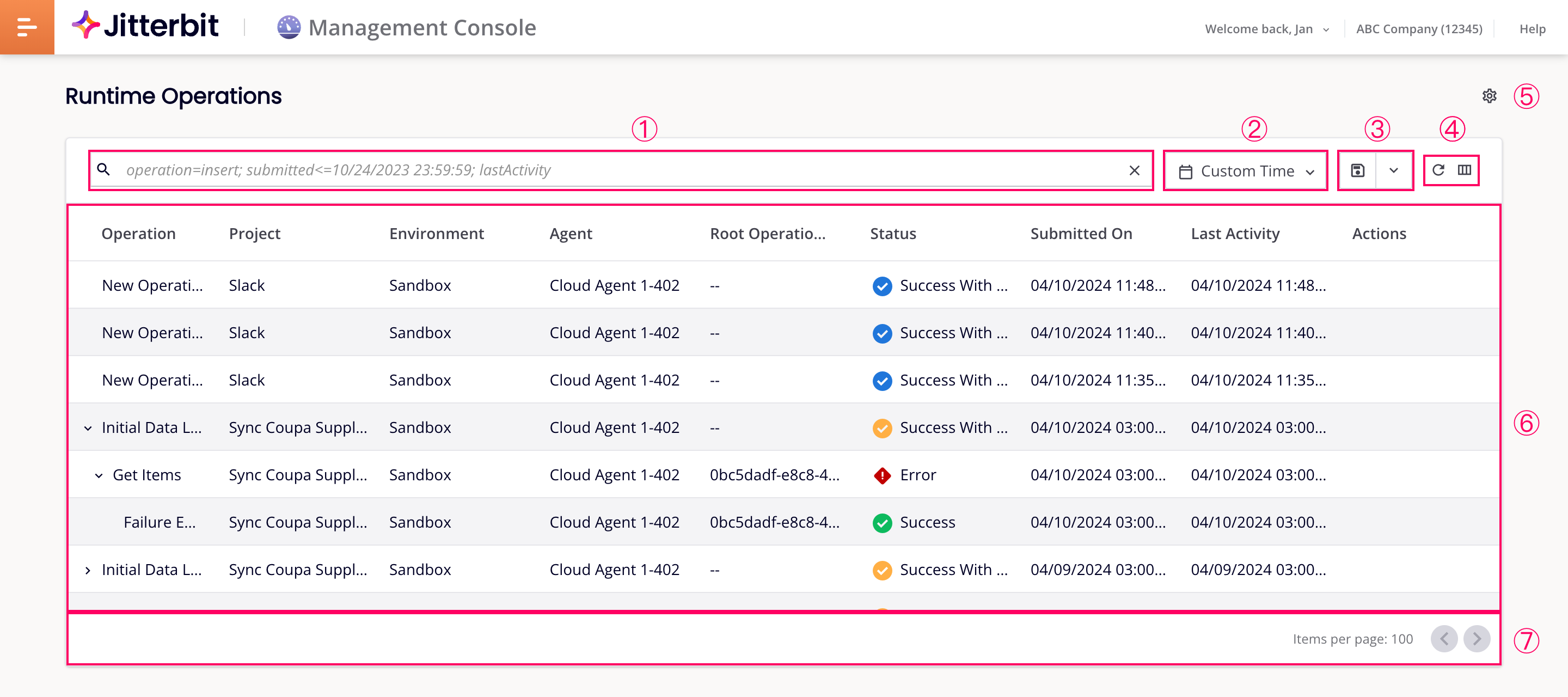Runtime Operations page in Jitterbit Management Console
Overview
| Purpose | View runtime operation logs |
| Location | Harmony portal menu > Management Console > Runtime Operations |
| Page access | Users with Admin role permission |
| Environment access | Users with Execute or View Logs environment access levels |
Introduction
The Runtime Operations page is a table of operation logs. When an operation is executed, an operation log is generated. An operation log contains information about when and where an operation ran, the operation status, the number of source and target records processed, and any log messages. Whether detailed log messages are displayed depends on permission and access levels and whether cloud logging is enabled. When operation debug logging (for cloud agents or for private agents) is enabled for an individual operation, each operation log also contains input and output data for the operation.
Note
Harmony keeps operation logs for 30 days.
By default, the Runtime Operations page does not show successful custom API or OData services API operations. To include them, enable operation debug logging on the operation, or, for private agents only, set EnableLogging=true in the [APIOperation] section of the private agent configuration file.
The page's tools and regions are mentioned throughout this document. They are identified in the image below:
Legend
① The Execution tree view toggle and page settings icon.
② The toolbar, comprising the following:
- Search bar
- Time range menu
- Save query and Saved queries icons
- Table refresh and filter columns icons
Operation details table
The available columns are as follows:
-
Operation: The name of the Studio or Design Studio operation. If an operation has children, click the Expand icon to reveal the entire chain. Click a Minimize icon to collapse an operation and its children.
-
Project: The name of the project where the operation is running.
-
Agent: The agent name.
-
Environment: The name of the environment the operation was deployed to.
-
Status: The status of the operation, one of the following:
- Submitted: An operation was submitted to the Harmony queue, but has not yet been accepted by an agent for execution.
- Received: An agent acknowledges receiving the request to run an operation.
- Pending: An operation is queued to run on an agent.
- Running: An agent is executing the operation.
- Cancel Requested: A request to cancel the operation has been made. Operations may show this status yet continue to run after canceling.
- Canceled: The operation was canceled.
- Success: The operation completed successfully.
- Success With Info: The operation completed successfully with non-fatal issues.
-
Success With Warning: The operation completed successfully with warnings as shown in the log messages.
Tip
An
extra subelementwarning in the log messages can generally be ignored. This warning indicates a connector's API payload returned more nodes or fields of data than those defined in the response data schema. -
Success With Child Error: The operation completed successfully, but one or more child operations suffered fatal errors. (Applies to synchronous operations.)
- Error: The operation failed.
- Soap Fault: The operation failed with a SOAP fault. (Applies to operations with Studio SOAP or Salesforce endpoints, or Design Studio web services or Salesforce endpoints.)
If an operation has operation debug logging enabled at the operation level, and the operation was run on a 10.48 or later agent, the Status column in the Debug Logging tab shows the status of the operation step:
- Complete: The operation step was executed and completed without any errors.
- Error: The operation step was executed but could not be completed due to an error.
- Incomplete: The operation step was not executed or completed. Possible reasons for this status include that the operation step is waiting to be executed or that there was an error in a previous operation step preventing the following step from executing.
-
Started: The time the operation run was requested.
- Finished: The time the operation's status last changed.
- Operation ID: The operation's globally unique identifier (GUID). (This column is hidden by default.)
- Root Operation Instance Guid: The globally unique identifier (GUID) of the operation's root (top-level) operation. This field is empty for root operations, and the column is hidden by default. To copy the value, hover on it, then click Copy content.
- Actions: Hover on an operation to reveal the following actions:
- Cancel Operations: Stop an operation that is in Submitted, Received, Pending, or Running status.
- Go to operation: Open the project in Studio, and select the operation.
When there are more than 100 operations, they are split into pages of 100 each. You can move through them using these navigation buttons at the bottom of the table:
- Previous Page: Go to the previous page.
- Next Page: Go to the next page.
To see an operation log's details, select one in the table. A drawer opens at the bottom of the window with four tabs, Messages, Activity Logs, Debug Files, and Debug Logging.
Messages tab

This tab shows the following:
-
Source Records: When using an FTP or Database activity as a source, the count of records that have been read from the source system is displayed. For other connectors, the count reads
0regardless of the number of source records. -
Target Records: When using an FTP or Database activity as a target, the count of records that have been posted to the target system is displayed. For other connectors, the count reads
0regardless of the number of target records. -
Message: Log details including any of the following:
- System-generated messages indicating that the operation completed without error.
- Information and warning messages returned by either the source or target systems.
- Validation warnings returned by the Jitterbit transformation, validation, and scripting services.
- User-defined messages generated by the Invoke Operation (Beta) tool (when Raise error if operation fails is enabled) or the
WriteToOperationLog()function.
Note
- Dates and times in log messages appear in their original format from the source and aren't converted to local browser time.
- Very large log messages may be truncated, denoted with
message truncatedappearing at the end of the log.
To see an operation's log messages in the Messages tab, the following must be true:
- You must be a member of a role with a minimum of Read organization permission and Execute environment access. (An environment access level of View Logs is not sufficient.)
- Cloud logging is enabled on the private agent group. (Cloud logging is always enabled on cloud agent groups.) When disabled, and if your network configuration lets you connect directly to the agent host, log messages can be viewed securely by clicking the link View log messages from Agent.
Activity Logs tab

This tab contains links to success or failure files created by the Salesforce, Salesforce Service Cloud, or ServiceMax activities running on a private agent.
The files are in CSV format. To download one, click on its link.
Activity log files are automatically deleted after 14 days by the private agent's file cleanup service. You can change this behavior in the [ResultFiles] section of the private agent jitterbit.conf file, or by changing the file cleanup service rules.
Activity log downloads are disabled for cloud agents. You may see download links for cloud agent activity logs, but attempting to download logs generates an error message.
Debug Files tab

When debug logging is enabled for private agents, this tab contains a link to download operation debug log files. The debug files are removed after 1 day by default, or as configured in a private agent's cleanup rules.
Debug log file downloads are disabled for cloud agents. You may see download links for cloud agent debug files, but attempting to download files generates an error message.
Debug Logging tab
When debug logging is enabled at the operation level (for cloud agents or for private agents) and the operation was run on a 10.48 or later agent, this tab shows the details of a Studio operation's full execution hierarchy. The operation log view displays a split view with operation logs in the left panel and detailed log information for the selected operation in the right panel. The view uses the selected table controls to filter results. If operations are chained with operation actions or the RunOperation function, those operations are listed under the parent operation.
Parent operations (and any child operations beneath them) are sorted in ascending order by Started. The table can be sorted (for top-level operations only) by Name, Started, Finished, Duration, or Status by clicking the respective header row.

-
Name: The name of the operation or operation step. The carets, which can be used to expand or collapse additional rows, are shown on parent operations and on operations for which component input and output data are available:
- Parent operations: When a parent operation is expanded, additional rows for its child operations appear in the order in which they were executed. By default, all parent operations are expanded. Use the collapse list or expand list icons to collapse or expand all parent operations.
-
Started: The date and time the operation or operation step began running, displayed as the local browser time.
-
Finished: The date and time the operation or operation step stopped running, displayed as the local browser time.
-
Duration: The time elapsed between Started and Finished, reported in seconds for operations and in milliseconds for operation steps.
-
Status: The status of the operation or operation step. For a complete list of possible statuses, see Operation details table earlier on this page.
-
Actions: These actions are available:
-
Cancel operation: Enabled for operations that are in Submitted, Received, Pending, or Running status.
Cancel operation sends a request to the agent to stop the operation. Once clicked, the Cancel Requested status is displayed next to the real-time operation status.
Note
Operations that have a Cancel Requested status may still run.
-
Go to operation: Open the project in Studio, and select the operation.
-
-
Refresh: Click to refresh the list of operation logs.
-
Filter Columns: Click to open a drawer that allows you to reorder the columns or adjust their visibility in the operation list panel:

-
Show All: Make all columns visible.
-
Move: Drag and drop to change the position of the column relative to others.
-
Hide: The column is visible. Click to hide it.
-
Show: The column is hidden. Click to show it.
-
-
Operation log: To show or hide a log for an individual operation, click an operation from the list.
-
Log messages: Log messages include the log details for the selected operation. Whether log messages are displayed depends on the current user's permissions and access levels and whether cloud logging is enabled. For more information, see Messages tab earlier on this page.
Note
Dates and times displayed within the log messages themselves are not converted to local browser time, but are reported in their original format from the source of the log message.
-
Copy: Copies the log data to your clipboard.
- Download: Downloads the log messages as a text file.
- Show / hide: Shows or hides the log messages.
-
Component input and output data
Component input and output data is generated when an operation has operation debug logging enabled at the operation level (for cloud agents or for private agents) and the operation was run on a 10.48 or later agent.
Note
The generation of component input and output data is unaffected by the agent group setting Cloud logging enabled. Component input and output data will be logged to the Harmony cloud even if cloud logging is disabled.
To disable generation of component input and output data in a private agent group, in the private agent configuration file under the [VerboseLogging] section, set verbose.logging.enable=false.
Warning
When component input and output data are generated, all request and response data for that operation are logged to the Harmony cloud and remain there for 30 days. Be aware that personally identifiable information (PII) and sensitive data such as credentials provided in a request payload will be visible in clear text in the input and output data within the Harmony cloud logs.
When component input and output data is present, a graphical representation of the operation or operation step is displayed in the operation list panel.
Icons for activities and transformations used as operation steps are displayed. You can click an operation step to show or hide the component input and output data for that individual operation step. Each input and output log entry is limited to 100 MB. If the data for an individual input or output log entry exceeds 100 MB, no data will be displayed.
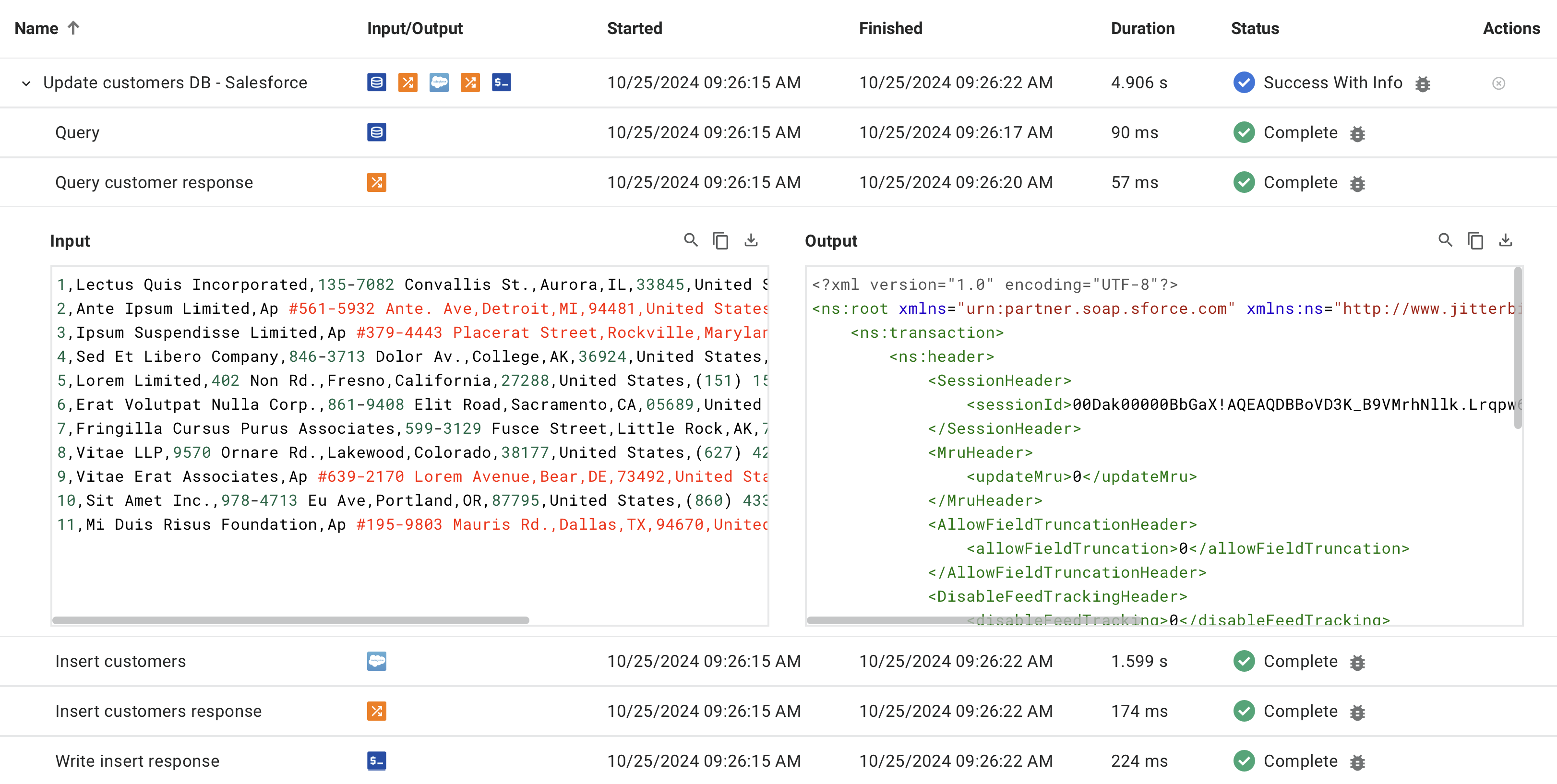
- Search: Search the data for the entered text.
- Copy: Copies the log data to your clipboard.
- Download: Downloads the input or output data as a file in the appropriate data format. The file is named with the operation step name followed by
_inputor_outputas appropriate.
Queries
A query is one or more key/value terms. Multiple terms are separated by semicolons. A term has the form <key><operator><value>. For the operation, project, environment, agent keys, values can include a wild card character, %, which matches any string.
To use a query, enter a valid query specification in the search bar then press return:

When the Execution tree view toggle is enabled, a query using the operation key (described below) returns results for the full hierarchy of any parent or child operations linked to the operation. The keyword string is highlighted in blue within the results. When the Execution tree view toggle is disabled, only operations matching the query are returned.
The following table shows the available query term components:
| Key | Key column | Allowed Operators |
Value | Notes |
|---|---|---|---|---|
operation |
Operation | = |
Operation name | |
project |
Project | = |
Project name | |
environment |
Environment | = |
Environment name | |
agent |
Agent | = |
Agent name | |
status |
Status | = |
Status name | The string shown in the Status column of the operation details table. |
started |
Started | <= |
Date/time | Date/time: month/day/year date format, with optional hour:minute:second time in AM/PM form. Date only: MM/DD/YYYY. Date and time (AM): MM/DD/YYYY HH:MM:SS AM. Date and time (PM): MM/DD/YYYY HH:MM:SS PM. |
>= |
||||
finished |
Finished | <= |
Date/time | |
>= |
||||
rootOperationInstanceGuid |
Root Operation Instance Guid | = |
Root operation's GUID |
Query examples
The following are example query terms:
| Query term | Description |
|---|---|
operation=New Delete; |
Show the "New Delete" operation. |
operation=New%; |
Show operation logs for operations with names that begin with "New". |
project=SFDC-SAP; |
Show operation logs for operations in the "SFDC-SAP" project. |
project=SFDC%; |
Show operation logs for operations in any projects with names beginning with "SFDC". |
environment=DEnv; |
Show operation logs for operations deployed in the "DEnv" environment. |
environment=DE%; |
Show operation logs for operations deployed to environments with names beginning with "DE". |
agent=Windows%; |
Show operation logs for operations running on agents with names beginning with "Windows". |
status=success; |
Show operation logs for operations with status "SUCCESS". |
started>=9/12/2024; |
Show operation logs for operations started on or after 9/12/2024. |
started>=9/12/2024 11:59:00 AM; |
Show operation logs for operations started on or after 11:59 on the morning of 9/12/2024. |
finished<=10/04/2024; |
Show operation logs for operations last active on or before 10/04/2024. |
finished>=10/04/2024 01:00:00 PM; |
Show operation logs for operations last active on or after 10/04/2024 at 1 PM. |
message=1201 alarm; |
Show operation logs for operations containing the message string "1201 alarm". |
rootOperationInstanceGuid=0f04b6f6-4129-45dd-8388-abd19fe6a4f7; |
Show operation logs for operations that are children of the root operation with the GUID shown. |
Note
Dates are specified and displayed in your browser's time zone.
Saved queries
Queries can be saved and used, then edited or deleted, as follows:
-
To save a query, click Save query. The query form opens:
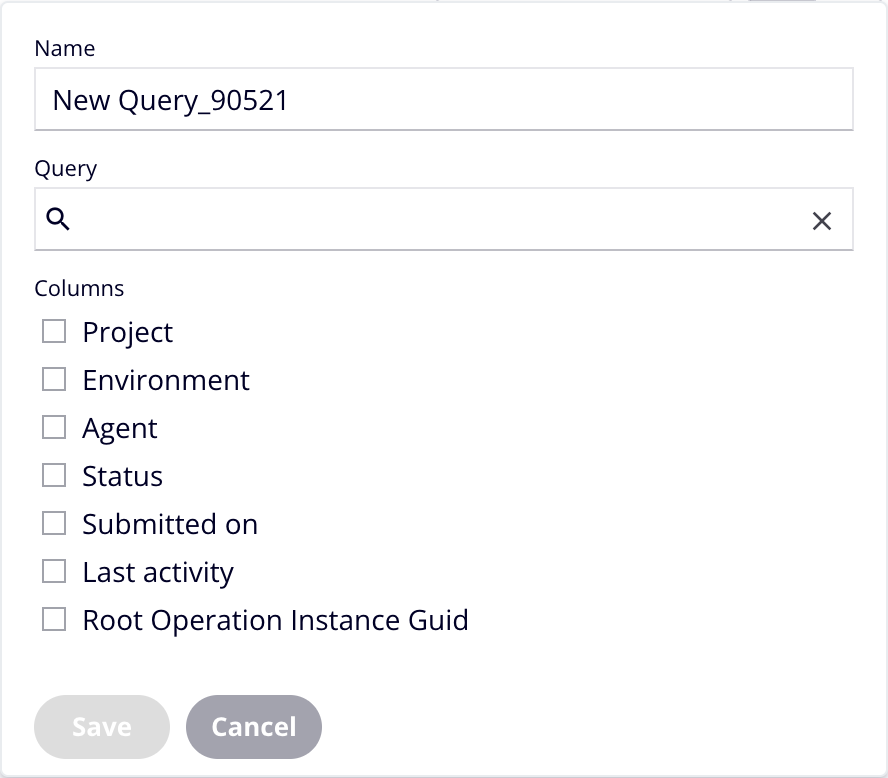
Enter or select values for the following fields, then click Save:
- Name: A name for the query.
- Query: One or more query terms using the same syntax as the search bar. You can add terms in the following ways:
- Click the field to show a list of available search terms. Select one to enter it into the query field, then add an operator and a value.
- Select one of the query suggestions.
- Enter a query term, followed by a semicolon.
-
Columns: Select the columns to display in the search results.
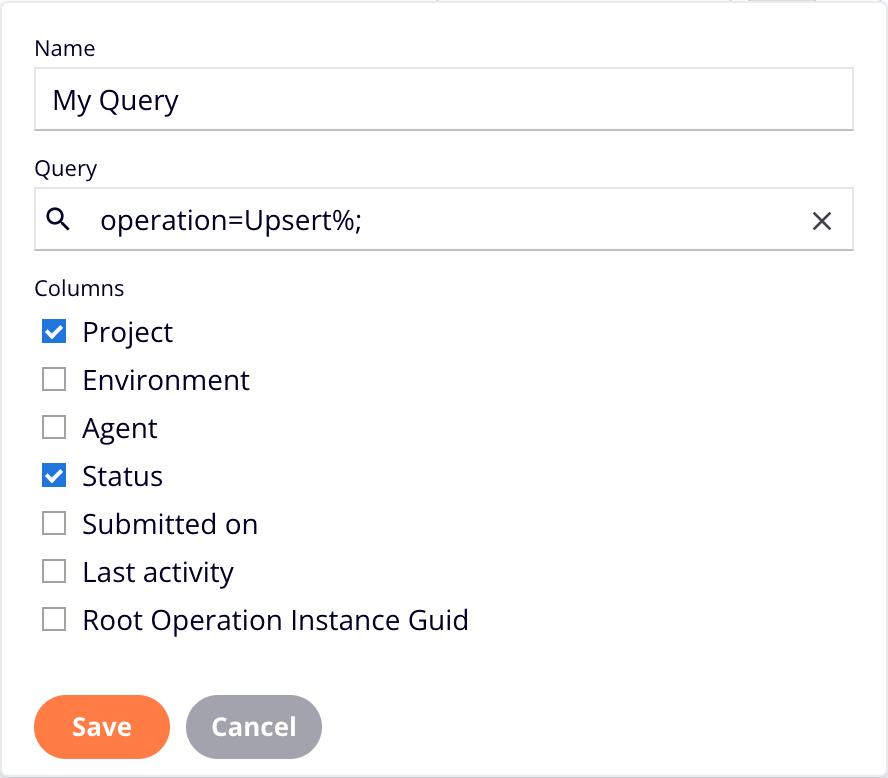
When saved, the Saved queries form opens:
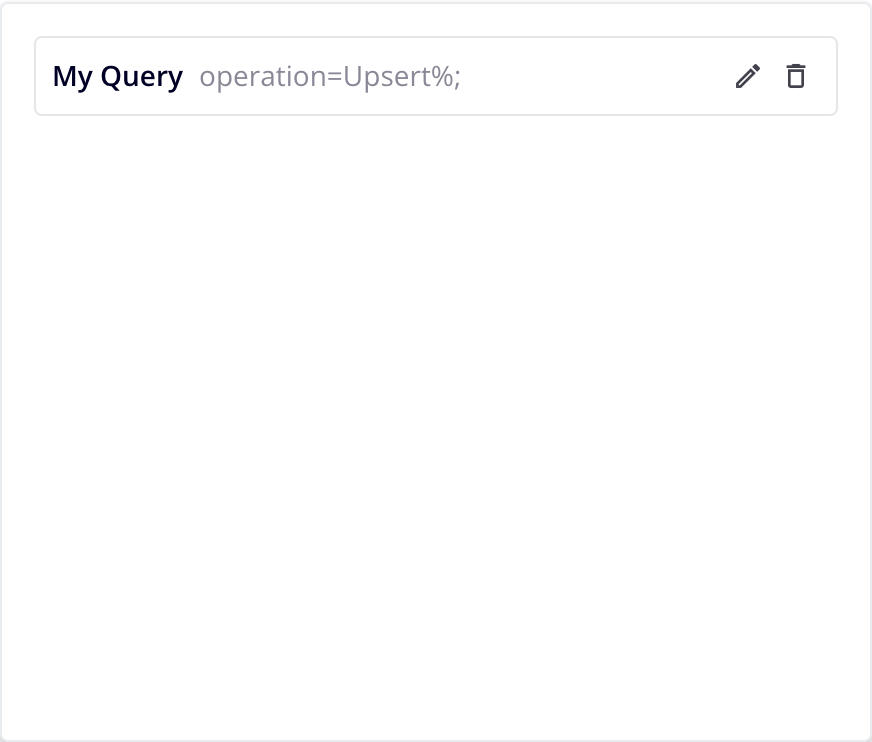
Click Saved queries to close it.
-
To use a saved query, click Saved queries, then click the query you want to run. The query terms are copied to the query bar, and the query runs automatically.
-
To edit a saved query, click Saved queries, click the Edit icon for query you want to edit. The query opens in the Edit query drawer:
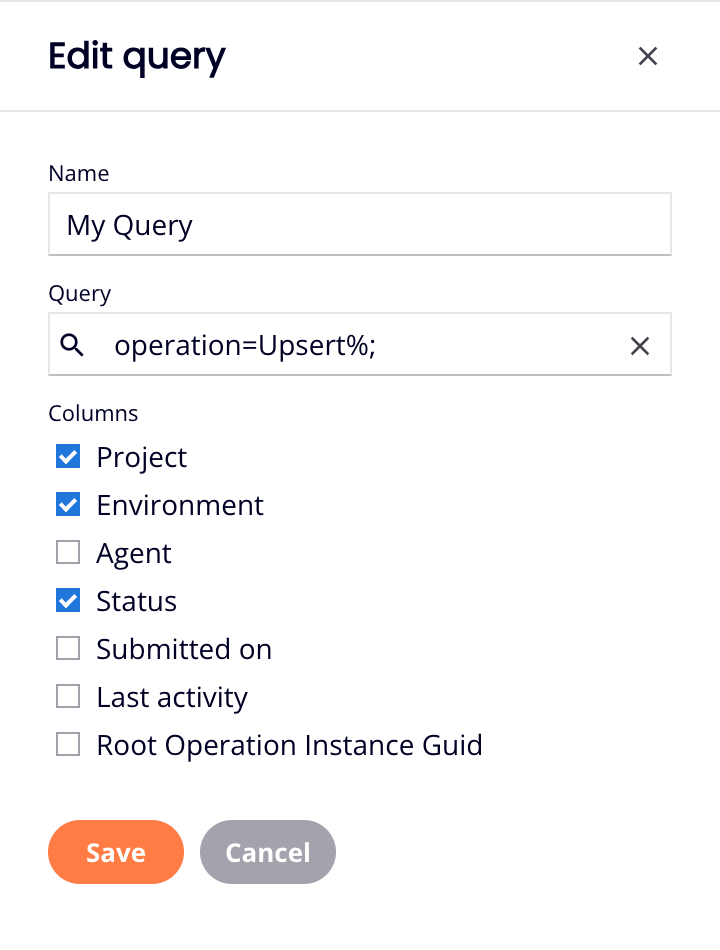
Edit the query, then click Save to save it, or Cancel to cancel.
-
To delete a saved query, click Saved queries, then click the Delete icon for the one you want to delete. A Delete Saved Query dialog asks you to confirm. Click Delete to continue, or Cancel to cancel.
Time range
The Runtime Operations page returns time period shown in the time range menu:

To change the period, open the menu and select one of the following options:
-
Last 24 hours
-
Last 48 hours
-
Last 72 hours
-
Custom time: Select to open the Custom time dialog. With this, you can filter operations based on the dates for the Started and Finished fields:
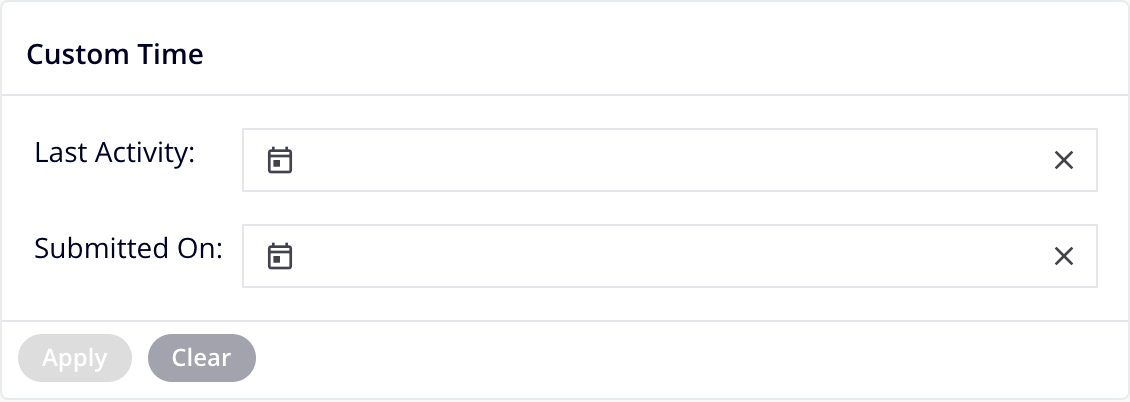
Click a calendar icon to open a date picker for a field:

Set either or both of the from or to dates using the calendar. Your browser's locale determines how dates are shown.
To set a time enter the hour and minute (in
HH:MM) format and the time period (AMorPM).Click anywhere on the Custom Time dialog to close the date picker.
When either or both field date ranges are set, click Apply. To clear the range, click Clear. To clear a field's dates, click its icon.
Page settings
You can sort the table, rearrange its columns, or refresh its contents:
-
Sort: To sort the table in ascending order, click any column heading. Click again to reverse the sort order.
-
Columns: To change the arrangement and visibility of columns, click Filter Columns. The Columns drawer opens:

The drawer has the following controls:
- Show All: Make all columns visible.
- Move: Drag and drop to change the position of the column relative to others.
- Hide: The column is visible. Click to hide it.
- Show: The column is hidden. Click to show it.
- Save: Save the columns.
- Cancel: Close the columns drawer without saving changes.
-
Refresh: The table updates automatically.
To change the automatic refresh interval, click Settings. The Settings drawer opens:

Select an auto refresh interval, one of Never (the default), 1 minute, 5 minutes, 15 minutes, or 30 minutes, then click the Save button.
To refresh the table at any time, click Refresh.

